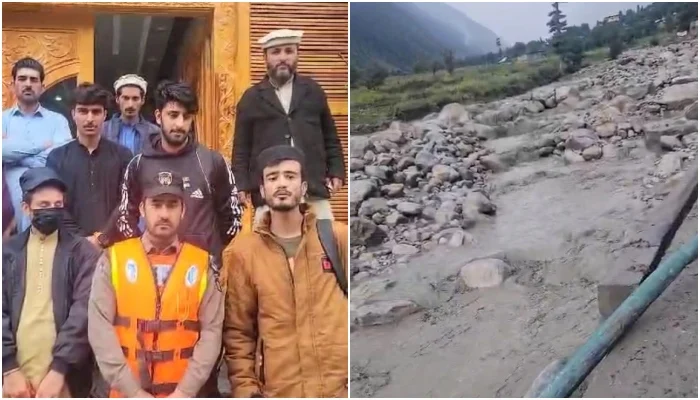
Kumrat Valley, a stunning location situated in the Upper Dir District of Khyber Pakhtunkhwa, Pakistan, recently encountered an unforeseen natural challenge. Intense rainfall caused flash floods and landslides, stranding approximately 200 tourists in the beautiful yet hazardous landscape of this cherished valley. Thankfully, the situation was promptly addressed as rescue efforts were initiated to guarantee the safe return of these tourists to their homes.
The Unforeseen Rainfall and Its Impact on Kumrat Valley
Kumrat Valley is famous for its verdant meadows, thick forests, and the calm waters of the Panjkora River. Unfortunately, this peaceful setting became dangerous as torrential rains hit the region. The intense rainfall caused flash floods and landslides, obstructing access roads and leaving tourists stranded who had come to enjoy the valley’s allure.
The Severity of the Weather Conditions
The rainstorm was unusually intense, resulting in rivers and streams overflowing their banks, which made several routes impassable. According to local meteorological reports, the rainfall exceeded normal levels, which was unexpected during this season. The sudden rise in water levels also submerged camping sites and popular tourist spots, including the scenic Jahaz Banda and the majestic Kumrat Waterfall.
Electricity and communication lines were severely disrupted, adding to the challenges faced by the stranded tourists. Many found themselves cut off from the outside world, with little to no way of seeking help or informing their families of their predicament. The lack of cellular signals further compounded their distress, highlighting the critical need for a swift and efficient rescue mission.
Swift Response from Rescue Teams
The rescue operations were promptly initiated by the local authorities, including the Khyber Pakhtunkhwa Rescue 1122 teams, district administration, and local volunteers. The army and paramilitary forces also played a pivotal role, deploying helicopters and heavy machinery to evacuate the stranded tourists.
Coordination Among Various Agencies
Rescue operations were challenging due to the treacherous terrain and ongoing rainfall, but the combined efforts of multiple agencies ensured a coordinated and timely response. Teams navigated flooded areas, cleared blocked roads, and set up temporary shelters to provide immediate relief to those affected.
Medical teams were on standby to assist with any health concerns, providing first aid to those who needed it. The rescue teams also distributed food, water, and warm clothing, ensuring the tourists were kept safe and comfortable until they could be evacuated.
Stories of Resilience and Survival
The tourists, many of whom were families and young adventurers, displayed remarkable resilience during the ordeal. Some shared harrowing accounts of their experience, emphasizing how the unexpected turn of events transformed a pleasant trip into a test of endurance.
Experiences of the Stranded Tourists
Several tourists described how they braved the cold, wet conditions by finding shelter in makeshift tents and vehicles. Local hospitality shone through, with nearby villagers providing food and warmth to those stranded. In the face of adversity, both locals and tourists demonstrated incredible community spirit and mutual support.
One group of travelers recounted how they huddled together in a safe spot, rationing food and keeping spirits high by singing songs and sharing stories. “We were scared but hopeful,” one tourist said. “We knew help would come, and it did.”
Challenges Faced During Rescue Operations
Despite the success of the rescue mission, it was not without its challenges. The rough weather conditions and ongoing landslides made it difficult for rescue teams to navigate the area. Helicopters faced visibility issues due to thick fog, and road-clearing operations were often halted by further rainfall.
Technical and Logistical Obstacles
One of the major hurdles was the removal of debris blocking key access routes. Heavy machinery was brought in, but constant rain caused delays. Furthermore, the difficult terrain meant that traditional rescue vehicles could not reach certain areas, forcing rescue teams to proceed on foot.
The local administration worked tirelessly to manage the logistical aspects of the operation, coordinating food and medical supplies while ensuring that the rescue teams had the necessary equipment to carry out their duties effectively. Despite these obstacles, the resilience and dedication of all involved led to a successful outcome.
The Aftermath: Ensuring Safety in Future Tourism
The rescue operation in Kumrat Valley has highlighted the importance of preparedness in managing natural disasters, especially in tourist destinations prone to extreme weather. Moving forward, it is crucial to develop better safety protocols and improve communication infrastructure to avoid similar incidents.
Enhanced Safety Measures for Future Tourists
Local authorities have been urged to install early warning systems and improve weather forecasting to better predict and manage such situations. There is also a growing call for better infrastructure, such as reinforced roads and bridges, to withstand extreme weather conditions.
Tourists are advised to stay updated on weather conditions and to avoid travel during adverse weather warnings. Moreover, local businesses and tour operators are being encouraged to provide safety training and emergency contact information to all visitors.
Conclusion: A Triumph of Teamwork and Human Spirit
The successful rescue of 200 tourists from Kumrat Valley is a testament to the resilience, bravery, and cooperation of all involved. The incident serves as a reminder of the unpredictable power of nature and the importance of community spirit in overcoming adversity. As Kumrat Valley slowly recovers, it remains a symbol of Pakistan’s stunning natural beauty and the indomitable human spirit.
Tourists are now safely back with their families, carrying with them not only memories of Kumrat’s landscapes but also tales of survival and solidarity that will last a lifetime.



